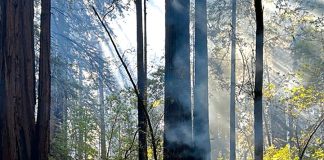When the air quality in Santa Cruz County was given an “F” by the American Lung Association earlier in the year, people took notice. After all, residents were use to an “A” based on the Santa Cruz Mountains’ barrier to Silicon Valley’s pollution and the Bay’s clean winds.
The ALA had been receiving air standards results from a site in Santa Cruz, not from the San Lorenzo Valley. After air quality monitors were installed in Scotts Valley and in the San Lorenzo Valley at the Middle School a few years ago, a major inconsistency between the two areas became evident.
While the Scotts Valley station showed excellent air quality results, the monitor at the SLVMS showed high levels of fine particulate matter particles that are inhalable during the winter months.
Smoke from fireplaces and wood stoves cause the high levels of particulate matter, while the Valley’s unique geography and wintertime inversion keep the smoke from escaping. The Monterey Bay Unified Air Pollution Control District recorded 20 to 40 violations per year for the area in the first three winters they monitored. When the particulate matter is above Federal Ambient Air Quality Standards, residents with certain health issues can be affected.
The District monitors air quality in Santa Cruz, Monterey, and San Benito Counties, which have never gone over the standards in 15 years of monitoring. Last winter, which was the fourth year of monitoring in the Valley, was warmer than usual and fewer violations were noted.
Some SLV residents took the winter results to the American Lung Association, who changed the rating for the County to an “F.” Bob Nunes, an air planner for the District, disagreed with the decision.
“I don’t think the rating is representative of the County in general. What’s happening in the San Lorenzo Valley is due to a microclimate and it’s a very small area compared to the rest of the County. I don’t think it’s appropriate to characterize the entire county with an F,” he said.
To learn about the air quality where you live, Nunes advises checking out http://mbuapcd.org/ and clicking on “Air Quality” where you will find a suite of measurements.
By clicking next on “Current” you can locate local stations in the “Good” range for ozone at this time of year. Ozone measures the pollution from cars, which gets worse as the season warms. The SLV Middle School stands now at “Good” for particulate matter.
In an attempt to increase air quality standards, Fifth District Supervisor Bruce McPherson and his staff analyst, Robin Musitelli, enlisted the help of residents to brainstorm ideas. Known as the Woodsmoke Stakeholders, the group is working on initiatives concerning requirements for woodstoves and fireplaces in new constructions, the “Don’t Damper Down” campaign, citations/classes for dirty burning, and others.
At last Monday’s meeting, Musitelli reports that ideas included restricting the resale of old wood stoves, forming a joint program with the County and the Valley Women’s Club to produce a coloring book for kids showing how they can stop air pollution, and buyer/owner conditions of escrow to change-out old wood burning stoves to clean burning heating, like pellet stoves.
Nunes reminds citizens of another form of air pollution — residential stack burns. As of May 1, 2015, the California Department of Forestry and Fire Protection (CAL FIRE) requires a burn permit for any outdoor open burning in State Responsibility Areas (SRA). SRAs are generally the unincorporated, rural, grass, brush and timber covered lands, like the San Lorenzo Valley. Contact CAL FIRE for permits and other fire control information at http://www.santacruzcountyfire.com/ or call 831-335-5353 in Felton.












